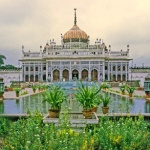Sights Lucknow, India
 Unusual sandstone monuments are now lost in modern Lucknow, still stand silent witnesses euphoric atmosphere of a unique culture.
Unusual sandstone monuments are now lost in modern Lucknow, still stand silent witnesses euphoric atmosphere of a unique culture.Also highlighted buildings built on European models, often decorated with flying buttresses, towers, domes and floral patterns, but the brick and mortar from which they were constructed, shows that they grow old, as well as the older stone buildings and the old Lucknow literally crumbling before our eyes.
Most of the attractions of Lucknow is situated along the southern coast of Gomti or close to it. In Lucknow, its architectural style, one of the most interesting specimens of late Indo-Muslim art.
In 1784 was built Bara (Big) Imambara - one of the largest facilities in the city. In the construction of the building has been involved 22 000 people. The complex consists of several buildings. It includes the mausoleum of Asaf ud Daula and his family, the tomb of a saint and a great Asafi Masjid mosque with many minarets, located on a broad area.
The complex is surrounded by a wall, which features a large ornamental gates Rumi Darwaza (gate Turkish), built on the model of one of the gates of Asia Minor in Istanbul (known in the Islamic world since the Byzantine Empire under the name "Rumi"), on both sides of the tower where splendid minarets . Center gate decorated with the image of two fish prince's coat of arms, which can be found on almost all navabskih buildings.
Mausoleum Bara Imambara widely known for its three huge vaulted halls. One of which is the largest in Asia (the length of 49,4 m, width 16,2 m, height 15 m). Hall was made without any external wood, iron or stone beams that support the body weight of about 20 000 tonnes.
Not far from the main bridge over the river is a modern commercial center Hazratgandzh, in the north where the river is Imambara Shah Najaf. Further to the west of the ruins of the residences, the road passes by the majestic Bara Imambary and leads through the large gate Rumi Darwaza to Imambare Husseynabad (Imambara Chhota).
To the south of it, between Hazratgandzhem and Charbaghom, confusion busy streets and markets is pretty old town district Aminabad. A little further west is richly adorned Imambara Husseynabad, also known as Chhota Imambara (Chota) ( "small"), or Palace of Lights, which is so called because of the fabulous appearance when on special occasions it specially dressed up and cover. Raised above the ground water reservoir in front of her, the path to which lies in a spacious courtyard, also serves to create a general festive atmosphere.
Over the whole ensemble, including the minarets, domes and arches of small and even rough miniatures of the Taj Mahal, is dominated by a central golden dome. In Imambare, built in 1837, Muhammad Ali Shah (1837 - 42 years.), Partly to alleviate hunger through the provision of poor people, is decorated with silver throne and tombs of important people Awadhi.
To the west of Imambary surrounded by the ruins of the rises in the sky are two minarets and three domes of Jama Masjid, whose construction was completed after the death of Mohammad Ali Shah, which does not admit non-Muslims. By Bara Imambare adjoins and overlooks her mosque Asaf-ud-Daula, located in the basement of the two-tier vaulted galleries with two tall minarets. It also closed to non-Muslims.
Among the hustle and bustle of modern Lucknow to the south is forgotten and abandoned palace Kayzarbagh. Already gone big chunks Kayzarbagh Palace, built in 1850, Wajid Ali Shah, who was to become the eighth wonder of the world. Museum of Folk Art in Kayzarbaghe is a large hall, which provided samples of Contemporary Art in Uttar Pradesh.
Ruins of residences rest in peace among the picturesque gardens in the south-east of the bridge Harding - the ruins left after the battle in exactly the same condition as they were after the lifting of the siege on Nov. 17, 1857 is damaged by a cannonball tower was a monument to the tenacity of the British in India and remains so even after Independence.
Now the peace and quiet Sikandrabaghe housed National Botanical Research Institute and a beautiful botanical garden with greenhouses, nurseries, gardens of roses and Bougainville and manicured lawns. Not far from the center Hazratgandzha is a small zoo in Lucknow, who also serves as an amusement park, which during the inspection of animals used a miniature train.
If you pass through the vast territory of the Zoo, the Museum will come to the state in which samples are exquisite sculptures of spotted red sandstone Mathurskoy school Kushan and Gupta periods (1-6 cc. N. E.).
In addition to sculptures from Gandhara, Nalanda and Shravasti, here is gallery terracotta products and even an Egyptian mummy. Musical instruments, paintings and costumes create a special atmosphere Galleries Awadhi, a division of Natural History - just a dream taxidermist.